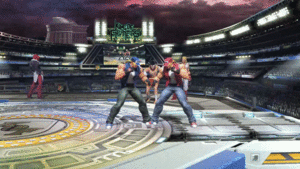Rising Tackle: Difference between revisions
(→Trivia) Tag: Mobile edit |
(Started langtable section, tagged it as incomplete) |
||
| Line 8: | Line 8: | ||
}} | }} | ||
'''Rising Tackle''' | '''Rising Tackle''' is [[Terry]]'s [[up special move]]. | ||
==Overview== | ==Overview== | ||
| Line 37: | Line 37: | ||
Terry SSBU Skill Preview Up Special.png|Terry using Rising Tackle as shown by a Skill Preview in ''Ultimate''. | Terry SSBU Skill Preview Up Special.png|Terry using Rising Tackle as shown by a Skill Preview in ''Ultimate''. | ||
</gallery> | </gallery> | ||
==Names in other languages== | |||
{{incomplete|Needs rest of names w/ according romanizations, confirmation that French + Spanish names are not NTSC specific}} | |||
{{Langtable | |||
|ja= {{ja|ライジングタックル|Raijingu Takkuru}}, ''Rising Tackle'' | |||
|en= Rising Tackle | |||
|fr_ca= Rising Tackle | |||
|es_la= Rising Tackle | |||
|de= Rising Tackle | |||
|it= Rising Tackle | |||
|nl= Tornadotackle | |||
}} | |||
==Trivia== | ==Trivia== | ||
| Line 42: | Line 54: | ||
{{Special Moves|char=Terry}} | {{Special Moves|char=Terry}} | ||
[[Category:Fatal Fury universe]] | [[Category:Fatal Fury universe]] | ||
[[Category:Up special moves]] | [[Category:Up special moves]] | ||
Revision as of 18:33, July 13, 2020
| Rising Tackle | |
|---|---|
 Rising Tackle in Ultimate. | |
| User | Terry |
| Universe | Fatal Fury |
Rising Tackle is Terry's up special move.
Overview
Terry flips onto his arms and propels himself upward, performing an upward corkscrew kick and hitting five times in the process. Terry yells "Rising Tackle!", "Hee-yah!" or "Bingo!" while using the move. It renders his entire lower body intangible from frames 9 to 20, and deals decent damage and knockback. It has light and heavy variants depending on whether the button is tapped or held; for the heavy version, Terry travels farther, and the move's final hit deals more damage. However, the move does not snap to the ledge immediately without precise spacing, leaving him vulnerable to edgeguards, even with the intangibility. It also has various advanced techniques available, such as charge partitioning.
Input Rising Tackle
If the player performs the command input (hold down ↓ for 24 frames, then input ↑+attack/special), Terry will perform an enhanced version of the move, which hits nine times instead of five, deals even more damage and knockback, goes a slightly higher distance, and grants him full-body intangibility from frames 5 to 17 in addition to lower-body intangibility on frames 18 to 25. The charge can be "hidden" through other animations, such as shielding or attacking. By tilting shield down, it is also possible to store charge for Rising Tackle, enabling it to be used as a powerful out of shield option.
Canceling
Terry can perform a Rising Tackle out of some standard attacks, as part of his special-canceling mechanic. By pressing the up special input or command input after connecting with one of certain standard attacks, Terry will cancel the endlag of the attack and perform a Rising Tackle. This can be used for combos. The most common moves this is used is out of are neutral attack or up aerial, allowing for kill options or general damage building.
The first two hits of Rising Tackle can be cancelled into Terry's Final Smash, Triple Wolf.
Instructional quote
| Strike against airborne threats by rising up feetfirst. Tilt the stick left or right to move slightly. |
Origin
Rising Tackle is Terry's anti-air move that has stuck with him since the original Fatal Fury, making an appearance alongside him in every following Fatal Fury title (except for Fatal Fury 3 and Garou: Mark of the Wolves; in the latter game, the move is instead used by Rock Howard) and later in the King of Fighters series.
Gallery
Names in other languages
| Language | Name |
|---|---|
| ライジングタックル, Rising Tackle | |
| Rising Tackle | |
| Rising Tackle | |
| Rising Tackle | |
| Rising Tackle | |
| Rising Tackle | |
| Tornadotackle |
Trivia
- Rising Tackle is the only move with a command input that utilizes a charge input.


